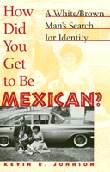Multiracialism: The Final Piece of the Puzzle
Excerpt from the book “How Did You Get Be Mexican,
A White/Brown Man’s Search for Identity“

by Kevin R. Johnson
August/September 2000
The increasing number of multi-racial people in the United States has generated legal difficulties because “the American legal system tody lacks intermediate or ‘mixed-race’ classifications.” This country has a long tradition of simply ignoring the existence of mixed-race people. The so-called “one-drop” rule, for example, classified as “African American” all persons who possessed “one-drop” of “black” blood. Though it made racial classifications administratively convenient for discriminatory purposes, this rule classifid as “black” an entire array of persons who varied greatly in terms of parentage and physical appearance.
When natualization laws required that a noncitizen be either “white” or of African descent to naturalize, the courts hadto grapple with how to classify persons of mixed heritage. Faced with the question whether noncitizen with an English father and a mother who was half-Chinese and half-Japanese was “white,” one court emphasized that “a person, one-half white and one-half of some other race, belongs to neither of those races, but is literally a half-breed” Following this reasoning and the one-drop rule, the courts consistently found that mixed-race persons were not “white” and were therefore ineligible for naturalization.
As these examples show, mixed-race people have been marginalized when not ignored altogether. The court’s derogatory characterization of them as “half-breeds” exemplifies this marginalization. Historically, academic theories have supported this treatment of mixed-race people. At the end of the nineteenth century, for example, scientists believed that a child of black and white parents was inferior, a racist notion that survives today in some quarters. The mixed heritage of Mexicans led to similar conclusions. As T.J. Farnham wrote in 1840,
- No one acquainted with the indolent, mixed race of California will ever believe that they will populate, much less, for any length of time, govern the country. The law of Nature which curses the mulatto here with a constitution less robust than that of either race from which he sprang, lays a similar penalty upon the mingling of the Indian and white races in California and Mexico. They must fade away….
Though animosity toward mixed-race people may be on the wane, “the rich diversity literally embodied by Multiracial people [has been] hidden from view, hidden from discourse, hidden from recognition and thus, invisible.” Lacking intermediate classifications, the law constructs a neat, dichotomous, unreal world.
In the 1990s the Bureau of the Census stirred up controversy by considering the addition of a multi-racial category to its racial classification scheme. Some African American leaders objected that mixed-race people who had always identified as black might begin to identify themselves as “multiracial,” thereby diluting the strength of blacks in electoral representation, affirmative action, and federal contracting programs.
The multiracial issue was again brought to national attention in 1997 by professional golfing sensation Tiger Woods, who claimed not to be African American, as many assumed, but “Cablinasion,” a mixture of Caucasian, African, Indian, and Asian. Some African Americans were offended that Woods, in their view, was denying that he was black. Whatever his declared racial background, however, Woods was the subject of slurs ad hate mail from people who assumed that he was African American.
The number of multiracial people in the United States will undoubtedly increase in the future, but how this may affect political and racial subordination in this country is far from clear. By blurring the lines between racial categories, multiracial people may destabilize the racial status quo. One might hope that the increasing number of multiracial people will build sympathy among members of dominant society as they become more familiar with, even related to, racial minorities.
Increasing numbers of multiracial children of mixed marriages may also be cause for hope. Interracial marriages, however, have occurred for centuries without a radical racial transformation. Given this nation’s racial history, one must guard against too optimistic an outlook.
Racial mixture is nothing new to Latinos. As the product of a long history of intermixture of Spanish, Indian, African, and other peoples, Mexican Americans, and Latinos more generally, represent a diverse mixture of races. In sharp contrast to the clear, unequivocal racial catergorization schemes constructed by U.S. law society, “Latinos, and especially Mexican Americans, have been conditioned by their history…to accept racial ambiguity and mixture as ‘normal.'” In contrast to the dim view of racial mixture taken by Anglo colonizers, Mexican philosophers saw it as a positive contribution to a raza comica or “cosmic race.” Like the boundaries between the races, Americans consider the U.S.-Mexico border a physically fixed location, while Mexicans refer to it as la frontera in much the same way that nineteenth-century Americans envisioned the American frontier. Though Latinos may accept racial ambiguity more readily than whites, U.S. society has traditionally imposed rigid racial classifications that raise difficult identity issues for persons of mixed Latino heritage.
Animus toward mixed Anglo/Latinos is generally less virulent than hostility toward other mixed-race persons, perhaps because of the long history of intermarriage between Anglos and persons of Mexican ancestry in the Southwest. For example, when my Uncle Brown-eyes married his Mexican American wife Rosie in the 1940s, few Anglos raised an eyebrow. Things would have been much different, I suspect, had he married a black woman.
Some mixed-background Latinos may be treated as “white” by the rest of society, but as with light-skinned blacks, the decision to “pass” has its costs. Professor Cheryl Harris offers teh sad example of the great pain her grandmother suffered in living two lives, working by day as “white” and returning home each night as black.
In the Southwest, to be stigmatized by Anglos as “Mexican” places one at a distinct disadvantage in certain circumstances. Like my mother and grandmother, some Latinos therefore attempt to pass as Spanish, but this brings other kinds of pain. My mother’s assimilation ordeals are an example of the psychological and other costs. My own experience as a mixed Anglo/Latino, though far less severe, has had its own share of pain.
Adrian Piper has captured the double-edged quality of the phenomenon of “passing” in her eloquent description of the experiences of an African American woman who could have passed as white but chose not to. Some blacks demanded proof that she was black; other subjected her to racial slurs. Then there were those who accused her of calling herself black only in order to reap affirmative action benefits. In addition, Piper resented fair-skinned family members who sealed themselves off from the rest of the higher status that way, they left their black family behind, with all the emotional turmoil and sadness that this entailed.
Attempts to “pass,” moreover, are not always successful, as my mother and grandmother learned at great cost. I well understand the Catch-22 in which Piper was caught. Being true to yourself subjects you to public scrutiny. Life under a microscrope can be disorienting, uncomfortable, and burdensome. And like her, I vacillate between understanding and resentment of the efforts of others to pass as white, with all the privileges and burdens that “passing” brings.
Whatever the assimilation route taken by Latinos who appear “white,” it is clear that their life experiences and identities are shaped y the knowledge that to be white is to be at the pinnacle of the social hierachy in the United States. Those who embrace their minority identity suffer a different set of costs from those who reject it. The point is that both choices come with costs- costs from which whites are generally immune.
There is no clear or easy answer to the question of how a person should classify herself when given an either/or choice rather than one that better reflects the complexities of race in modern America. Since there are no agreed-upon rules, identity choice by definition is arbitrary. As Linda Chavez, the daughter of a Latino father and British-Irish mother, explained, she had “very little identification with my mother’s background. I always thought of myself as Latina despite the fact that I didn’t speak Spanish.” Or take the case of the prominent federal judge, Harold Median, whose father was a Mexican immigrant and mother an Anglo. Though Medina is listed among Latinos in the Hispanic Almanac, another book claims that Reynaldo Garza, though he was appointed to the bench more than a decade after Medina, was the first Mexican American federal judge because “political figures…were unaware of [Medina’s] Mexican roots” at the time of his confirmation.
Some mixed Latinos classify themselves as white, others as Latino. Some identify as Latino at one time in their lives, perhaps in response to affirmative action considerations, but not at another. Without a clear classification rule, there is no clearly acceptable cours of conduct. Although one can understand that circumstances may lead to a change of identity (one may begin to identify with a particular group because of education, for example), strategic box checking should not be condoned. Minority identification for the purpose of gaining affirmative action and other benefits should in fact be discouraged and condemned as not serving any legitimate function, particularly when it is done exclusively to manipulate affirmative action programs for personal gain.
The ambiguity of racial classifications for mixed Latinos can be seen in the controversy involving Maria Hylton, a law professor with one white Australian and one black Cuban parent, who identified herself as black rather tha Latina when she was being considered for a faculty position at Northwestern University School of Law in Chicago. But was Hylton black? An African American professor at Northwestern claimed that because her background differed from that of most African Americans in the United States, she was not.
Conundrums like these have led to increased academic attention to the experiences of multiracial peoples in the form of a new field of Critical “Mixed Race” Theory. Although African American legal scholars of white and African American parents have written books documenting their experience, there has been surprisingly little analysis of mixed Anglo/Latinos. But consider the diverse backgrounds of a few mixed Latina and Latino law professors: a Latina with a “Cuban black” father and mother who was the daughter of Italian immigrants; a “Mexican, Irish, Jewish, Woman, Hetersexual, Aunt, Law Professor, Californian, Bostonian, Tusconian, middle child, professional” grappling with multiple identities; a Latino who is the son of a fourth-generation Irish father and a Salvadoran immigrant mother; a Latina with a Mexican immigrant mother and a Canadian father; one whose father was Irish and mother Mexican; a Latino from New Mexico whose mother was “Mexican American, his father Anglo-American”; and a Latina “born in Cuba [who] grew up in Puerto Rico.”
The identity complexities in my own life suggest some of the issues that society must grapple with in the future. For the most part, I have been accepted by both the Mexican American and Anglo communities. At the same time, I am self-conscious about where I fit in, fully aware that racial politics are a treacherous minefield. I am occasionally reminded in no uncertain terms that might not be employed, or at least not by as good a law school, were it not for my Mexican American ancestry. Tenure has not cleared up the uncertainty or stopped the questions and reminders. Though I have only one Mexican American parent, my own Latino identity illustrates the volitional nature of racial identity. Assimilation, racial choice, and Latino diversity all come into play when I pose the question of where mixed Anglo-Lation persons – half brown, half white – fit into the heated identity politics of the modern United States.
As increasing numbers of multiracial people in the United States mature, they will grapple with some of the issues with which I have struggled. Mixed Latinos do not fit neatly into the dominant Anglo culture. At the same time, they may be viewed with suspicion by some Latinos. My experience ahs been that others await an explanation when I claim to be Mexican American, especially in the academic world, with its unique blend of racial politics.
Ultimately, persons of mixed background are left little space in the modern debate over race relations. With the increasing number of mixed-race Latinos and mixed-race people generally in the United States, one might expect more blurring of the physical differences traditionally used to demarcate the so-called races. Telling who is white and who is not on the basis of physical appearance will become increasingly difficult. How society will address these racial complexities remains far from clear.
About the Book
A White/Brown Man’s Search for Identity
by Kevin R. Johnson
 |
“A readable account of a life spent in the borderlands between racial identity”
“Engaging and warmly inviting. Funny and tragic by turns, this book has a momentum that carries the reader along. Johnson’s struggles reverberate beyond himself; the incidents he recounts, whether dramatic or small, apply to the lives of others who have had to deal with poverty, class origins, and racial stereotyping.” —Richard Delgado, co-editor of Critical White Studies: Looking Behind the Mirror
This compelling account of racial identity takes a close look at the question “Who is a Latino?” and determines where persons of mixed Anglo-Latino heritage fit into the racial dynamics of the United States. The son of a Mexican American mother and an Anglo father, Kevin Johnson has spent his life in the borderlands between racial identities. In this insightful book, he uses his experiences as a mixed Latino-Anglo to examine issues of diversity, assimilation, race relations, and affirmative action in contemporary United States.
Kevin R. Johnson is Associate Dean for Academic Affairs and Professor of Law and Chicana/o Studies at the University of California, Davis. He is author of a number of law review articles on civil procedure, civil rights, race relations, immigration law, and refugee law.
Copyright © 2000 Kevin R. Johnson. All rights reserved. {jos_sb_discuss:2}

